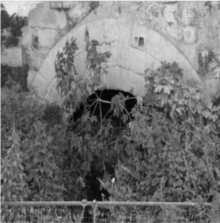Cloaca Circi Maximi

The Cloaca Circi Maximi or Cloaca Circi was one of the three main sewers in ancient Rome. Alongside the Cloaca Maxima and Chiavicone dell'Olmo[1]
History
The Cloaca Circi Maximi was built in the Augustan Period to clear Rome of unhealthy bodies of water.[2] It was originally a small stream fed by various sources from around the Porta Capena right through the valley between the Palatine Hill and Aventine Hill, running down to the river Tiber.[3] According to tradition, games and horse races were held in this valley from right after the founding of Rome in the 8th century.[citation needed]
Over the centuries the Circus Maximus was built over the stream, with a channel named Euripus running across it halfway and two bridges carrying the track over it. This sewer would drain the area around the Circus Maximus. [4] It also served as the spina down the middle of the track.[citation needed]
Under Julius Caesar and Augustus the circus and its surroundings were greatly enlarged, covering over the channel, which became a sewer. It was connected to a tunnel modelled on that of the Cloaca Maxima and now terminated on the Tiber upstream of the Cloaca Maxima.[citation needed]
Later in the sewer's history it was connected to culverts around the Colosseum and maybe the Baths of Caracalla.[4]
The Torre della Moletta, or Tower of Moletta was built upon the ruins of the Cloaca Circi Maximi.[3]
References
- ^ Haselberger, Lothar; Romano, David Gilman; Dumser, Elisha Ann; Borbonus, Dorian (2002). Mapping Augustan Rome. Journal of Roman Archaeology. ISBN 978-1-887829-50-2.
- ^ Angelakis, Andreas N.; Mays, Larry W.; Koutsoyiannis, Demetris; Mamassis, Nikos (2012-04-14). Evolution of Water Supply Through the Millennia. IWA Publishing. ISBN 978-1-84339-540-9.
- ^ a b Landart, Paula (2021-12-05). Finding Ancient Rome: Walks in the city. Paula Landart.
- ^ a b Bradley, Mark (2012-07-26). Rome, Pollution and Propriety: Dirt, Disease and Hygiene in the Eternal City from Antiquity to Modernity. Cambridge University Press. ISBN 978-1-139-53657-8.
Bibliography
- Evolution of Water Supply Through the Millennia, p 446 ISBN 9781843395409
- L. Richardson, jr, A New Topographical Dictionary of Ancient Rome, Baltimore - London 1992. pp.84. ISBN 0801843006
